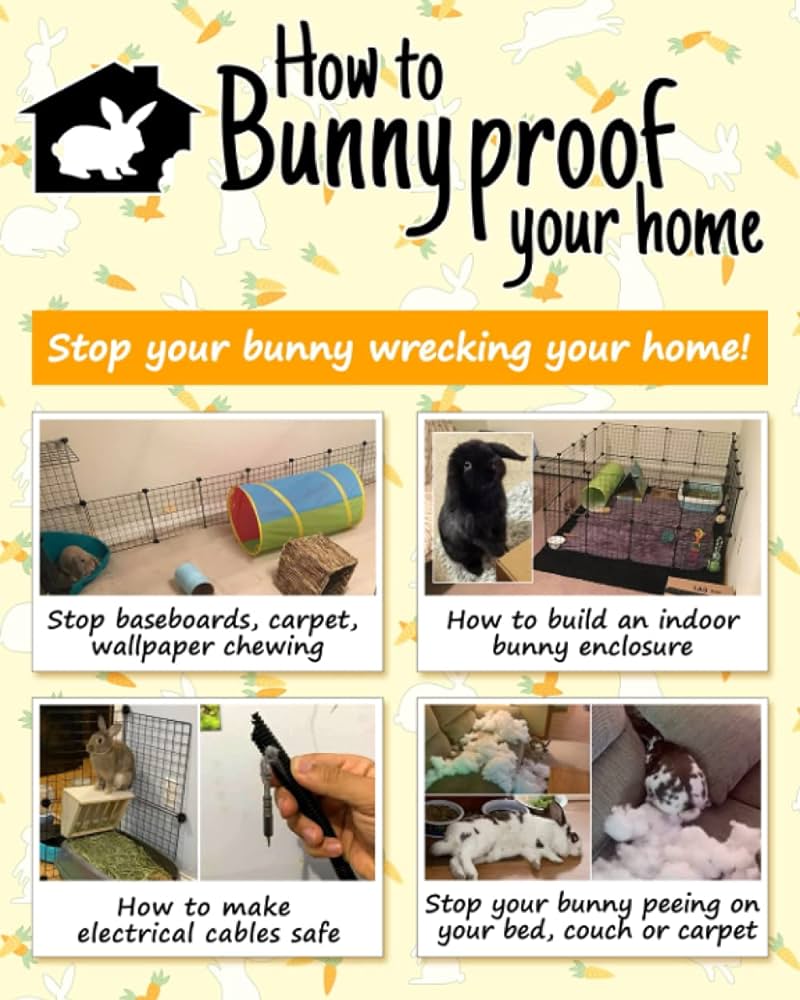Key Takeaways
-
Creating a safe space for a new rabbit involves careful planning and rabbit-proofing your home.
-
Identifying and securing potential danger zones in your house can prevent accidents and keep your rabbit safe.
-
Simple modifications to your home, like covering electrical cords and choosing rabbit-safe plants, can make a big difference.
-
Providing rabbit-safe hideouts and exercise areas is crucial for your rabbit’s well-being.
-
Regular supervision and maintenance of rabbit-proofed areas ensure ongoing safety for your furry friend.
Jump Right In: The Why and How of Securing a Bunny-Friendly Home
Welcome to the world of rabbit guardianship! If you’re preparing to bring home a new rabbit rescue, you’re about to embark on a delightful journey filled with love, laughter, and a bit of learning curve. But before you can enjoy the pitter-patter of bunny feet, you need to ensure your home is a safe and welcoming place for your new friend.

“bunny chewing electrical cables …” from www.amazon.com and used with no modifications.
The Importance of a Safe Haven for Rabbit Rescues
Why is rabbit-proofing your home so important? Well, rabbits are naturally curious and have a strong need to chew. Your house is full of potential hazards that can harm your bunny or lead to costly damages. Therefore, taking the time to create a secure environment is not just about keeping your rabbit out of trouble; it’s about ensuring their health and happiness.
First Steps to Take for a Rabbit-Ready Household
Before your rabbit sets foot (or paw) in your home, there are some crucial steps you should take:
-
Research: Understand rabbit behavior and needs. This knowledge will guide you in making your home bunny-friendly.
-
Space: Designate a specific area for your rabbit to call home. This could be a pen, a rabbit-proofed room, or a large cage with plenty of time allowed for exercise outside of it.
-
Supplies: Gather all the necessary supplies, including a litter box, water bottles or bowls, hay feeders, and safe toys.
With these foundational steps in place, you’re ready to dive into the details of rabbit-proofing and setting up your home for a hoppy life with your new companion.
Uninterrupted Hoppiness: Essential Rabbit-Proofing Strategies
Identify and Protect Danger Zones
Start by looking at your home from a rabbit’s eye view. Get down on the floor and take note of areas that might entice a curious bunny. These danger zones typically include:
-
Electrical cords
-
Loose carpeting or rugs
-
Houseplants
-
Accessible cabinets and drawers
Once you’ve identified these areas, it’s time to take action to secure them.
Electrical Cord Safety: No Bite Zones
Rabbits have sharp teeth that can easily slice through electrical cords, posing a serious risk of electrocution. To prevent this, encase cords in hard plastic sleeves, or conceal them behind furniture. If possible, elevate cords away from rabbit reach. It’s a simple step, but it’s crucial for your rabbit’s safety.
Protect Your Walls and Furniture
Rabbits also have a natural inclination to chew on baseboards, furniture legs, and even walls. To protect these items, you can use bitter sprays designed to deter chewing, or cover baseboards with plastic guards. For furniture, consider using covers or barriers to block access.
Rabbit-Resistant Plants and Decor
Many common houseplants are toxic to rabbits. It’s essential to either choose rabbit-safe plants or keep them completely out of reach. Also, reconsider any small, chewable decor that could be ingested by a curious bunny.
Remember, the goal here is not just to protect your belongings, but to create an environment where your rabbit can explore and play without any risk of injury. Stay tuned for more detailed strategies on creating rabbit-safe hideouts and making rabbit-friendly home modifications in the next parts of this guide. Your rabbit’s well-being depends on your diligence and love, so let’s make every corner of your home a safe haven for your new furry family member!
Protect Your Walls and Furniture
It’s not just electrical cords that need your attention. Rabbits view your walls and furniture as giant chew toys. To safeguard your home, consider these tips:
For walls, corner guards or plastic shields can be a saving grace. They’re usually adhesive and can be easily applied to the areas your rabbit finds most tempting. As for furniture, a simple yet effective method is to use furniture covers or to strategically place rabbit-safe toys and chew blocks around the house to redirect their gnawing instincts.
Rabbit-Resistant Plants and Decor
Did you know that many plants, like lilies and ivy, are toxic to rabbits? It’s crucial to research and ensure any plants within your rabbit’s reach are safe. Alternatively, hanging planters can keep greenery out of your bunny’s path. When it comes to decor, remember that if it’s small enough to fit in a rabbit’s mouth, it’s best kept out of the rabbit zone.
Hideaway Haven: Designing Rabbit-Safe Spaces
Rabbits are prey animals by nature, and they need a secure place to hide and rest. This means providing hideaways where they can retreat when they feel scared or just need some alone time. The hideouts should be sturdy, spacious, and free from potential hazards.
When choosing or creating hideaways, you need to consider the size of your rabbit. They should be able to enter, turn around, and lie down comfortably. Multiple exits are also a good idea so they never feel trapped.
Example: A cardboard box with two doorways cut out makes an excellent and cost-effective hideout. Just ensure there are no staples, tape, or other harmful materials on the box.
Hideaways also offer a great opportunity to use upcycled materials, which can be both eco-friendly and budget-friendly. Just make sure the materials are safe and non-toxic for your bunny.
Choosing the Right Rabbit Hideouts
When selecting hideouts, you have a variety of options. Pre-made hideouts are available at pet stores, but you can also get creative and make your own. Consider using untreated wood, sturdy baskets, or even repurposed furniture like end tables with a door added for privacy.
Most importantly, the hideouts should be easy to clean. Rabbits are clean animals, and their living spaces need to reflect that. Look for materials that won’t absorb odors and can be wiped down or laundered as needed.
DIY Safe Spots for Solace and Sleep
Creating a DIY hideout can be a fun project. A simple bookshelf turned on its back with the shelves removed makes for a great multi-level hideout. Add some soft bedding and you’ve created a rabbit palace. Just make sure there are no sharp edges or loose hardware.
Another idea is to use large PVC pipes for tunnels that lead to a cozy sleeping area. Rabbits love to explore tunnels, and PVC pipes are easy to clean and move around.
Modifying with Mindfulness: Rabbit-Friendly Home Adjustments
When you’re making your home rabbit-friendly, it’s not just about what you add, but also about what you modify. Look at your space with a critical eye and consider the following: bunny proofing tips and tricks to ensure your rabbit’s safety and comfort.
Non-toxic materials are a must in any space your rabbit will inhabit. This includes everything from the paint on the walls to the type of bedding you use. Rabbits have sensitive respiratory systems, so avoid anything that could off-gas harmful chemicals.
Non-Toxic Materials for Bunny Spaces
For paints, choose zero-VOC options. Bedding should be paper-based or made from natural fibers. Avoid cedar and pine shavings, as the oils they contain can be harmful to rabbits. Instead, opt for aspen shavings or recycled paper products.
When it comes to cleaning, white vinegar and water make an excellent rabbit-safe disinfectant. Avoid using household cleaners that contain strong chemicals or artificial fragrances.
Bunny-Proof Flooring for Unlimited Exploration
Rabbits need to hop, and your flooring choice can either help or hinder their movement. Carpeting provides great traction, but it’s also prone to chewing and can be difficult to clean. If you have hardwood or tile floors, consider adding some washable rugs or mats to give your rabbit the grip they need without sacrificing your floors to potential damage.
Lastly, make sure that any area rugs are secure on the floor to prevent them from slipping when your rabbit makes a run for it. Double-sided tape or a non-slip rug pad can do the trick.
With these rabbit-proofing strategies and mindful modifications, you’re well on your way to creating a home that’s both safe and enjoyable for your new rabbit rescue. In the next section, we’ll cover frequently asked questions to help you navigate common challenges in creating the perfect bunny-friendly home.
Frequently Asked Questions (FAQ)
How do I rabbit-proof my home when I have other pets?
When you have other pets, rabbit-proofing requires a few extra considerations. Make sure the rabbit’s space is separate and secure, ideally in a room where other pets can’t enter without supervision. Use baby gates or pet pens to create safe boundaries. It’s also important to gradually and safely introduce your rabbit to other pets under close supervision to ensure they can coexist peacefully.
Can I let my rabbit roam freely in the house after rabbit-proofing?
Yes, you can let your rabbit roam freely in the house after thorough rabbit-proofing, but always under supervision. Rabbits are curious and can find their way into trouble, so it’s best to keep an eye on them. Start with short, supervised sessions and gradually increase their freedom as you become more confident in the safety of your rabbit-proofed areas.
What are the best materials to use for building rabbit hideouts?
When building rabbit hideouts, the best materials are those that are safe and non-toxic. Untreated wood, cardboard, and natural grass mats are excellent choices. Avoid materials that splinter easily or have been treated with chemicals. Always ensure the stability and sturdiness of the hideouts to prevent any accidents.
Additionally, any adhesives or paints used should be non-toxic and safe for animals. Remember to avoid small parts that could be chewed off and ingested. You can also repurpose furniture, like bookshelves or end tables, as long as they are properly secured and free of any harmful substances.
How can I protect my furniture without restricting my rabbit’s space?
Protecting your furniture while giving your rabbit freedom to roam can be a balancing act. Use furniture covers, taste deterrent sprays, or physical barriers to prevent chewing. Providing plenty of rabbit-safe toys and chew alternatives will also help redirect their natural chewing behavior away from your furniture.
What should I do if my rabbit has a habit of chewing on hazardous materials?
If your rabbit has a habit of chewing on hazardous materials, it’s crucial to remove those materials from their environment immediately. Replace hazardous items with safe chew toys and regularly check for any new potential dangers. Consistent supervision and updating your rabbit-proofing measures will help prevent any mishaps.
Preparing your house for a new rabbit rescue involves several important steps to ensure the safety and comfort of your new pet. First, you need to rabbit-proof your home to prevent any accidents or injuries. This includes covering electrical cords, securing cabinets, and removing toxic plants. Additionally, creating rabbit-safe hideouts and areas where your rabbit can retreat to feel secure is essential. Finally, consider making rabbit-friendly home modifications, such as litterbox training your rabbit, to help them adapt to their new environment and become a happy member of your family.


